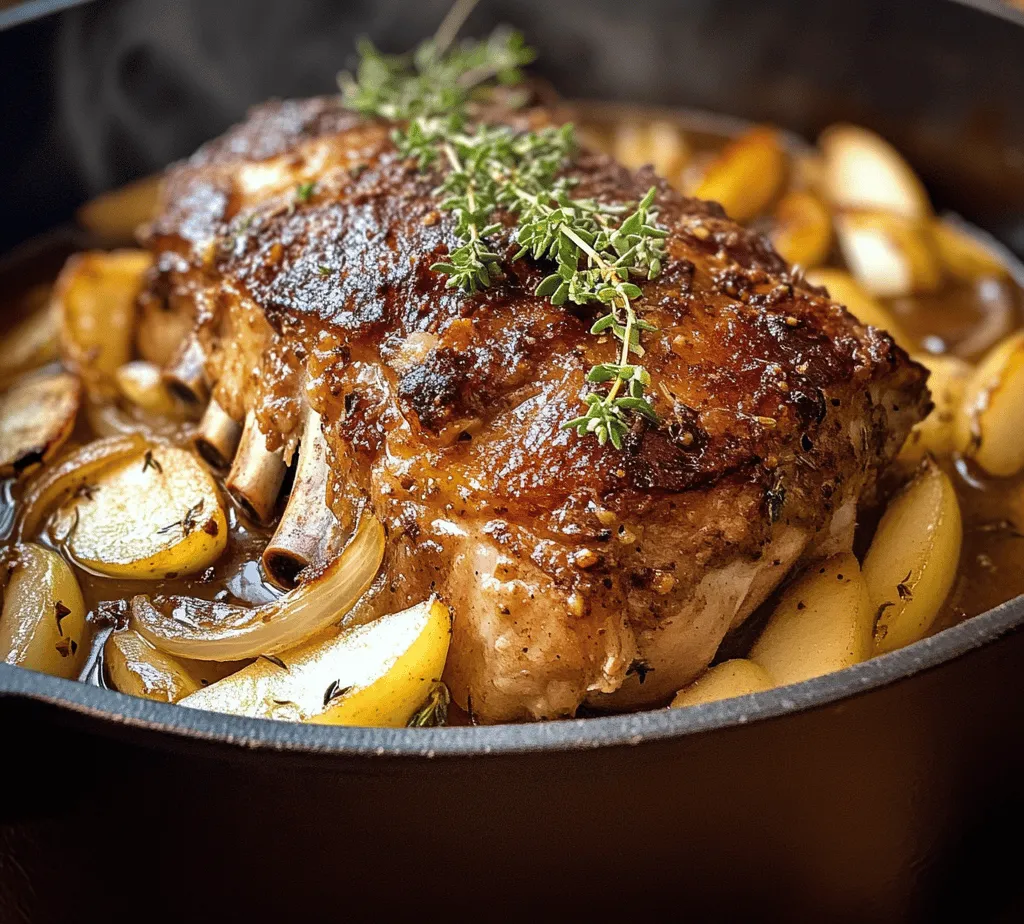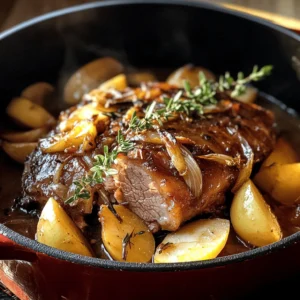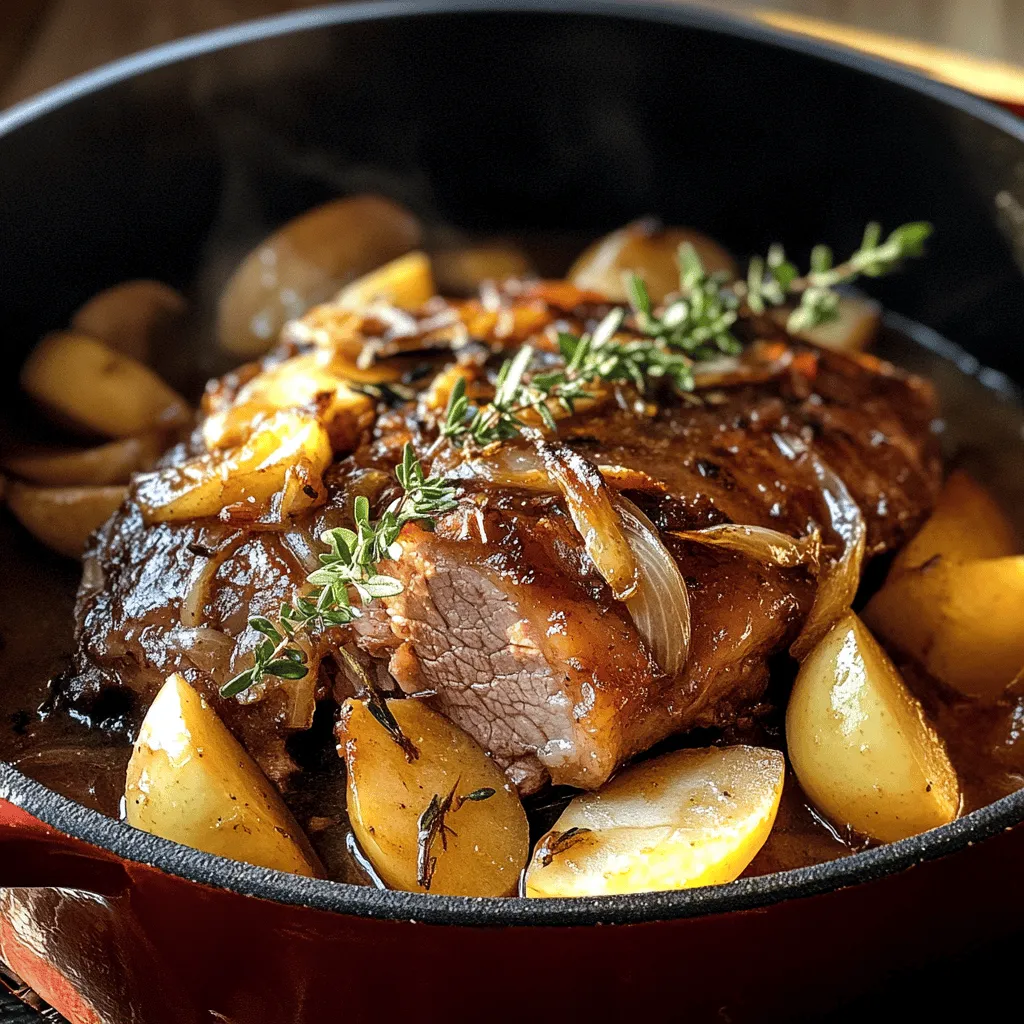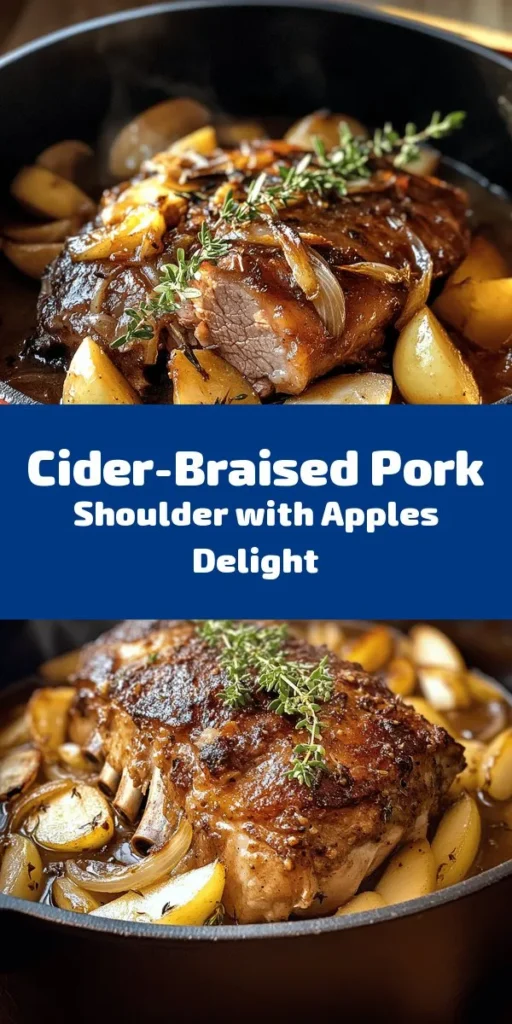Introduction
As the leaves start to turn and the crisp air heralds the arrival of autumn, there’s an undeniable shift in our culinary cravings. One dish that captures the essence of this season is Apple Cider Braised Pork Shoulder. This comforting recipe not only showcases the beloved flavors of fall but also embodies the heartiness that we often seek as we cozy up for the colder months. Picture succulent, tender pork shoulder infused with the sweet and tangy notes of apple cider, complemented by fresh herbs and aromatic vegetables. It’s a dish that warms the soul and brings a sense of home to your dining table.
Apple cider is more than just a seasonal beverage; it serves as a versatile ingredient that elevates various dishes. In this recipe, it plays a crucial role, imparting a depth of flavor that harmonizes beautifully with the pork. The marriage of apple cider and pork shoulder is a match made in culinary heaven, where the sweetness of the cider balances the rich, savory profile of the meat. This dish is not only an impressive centerpiece for gatherings but also a comforting meal perfect for family dinners.
Understanding Apple Cider Braised Pork Shoulder
At the heart of this dish lies the technique of braising, a method that transforms tougher cuts of meat into tender, flavorful bites. Braising involves cooking the pork shoulder slowly in a combination of liquid and aromatics, allowing the meat to absorb all the delightful flavors while becoming meltingly tender. This technique is particularly well-suited for pork shoulder, which benefits from low and slow cooking, breaking down collagen and fat to yield a juicy and succulent result.
Flavor infusion is key in braising. As the pork cooks, it releases its natural juices, which combine with the apple cider and other ingredients, creating a rich sauce that enhances the dish’s overall taste. The process of braising allows the ingredients to meld together, creating layers of flavor that are complex yet comforting.
Key Ingredients and Their Benefits
The success of Apple Cider Braised Pork Shoulder hinges on its ingredients. Let’s take a closer look at the key components that contribute to this dish’s mouthwatering profile.
Pork Shoulder
Pork shoulder, also known as pork butt or Boston butt, is the star of this recipe. This cut comes from the upper part of the pig’s front leg and is known for its high-fat content and marbling, which makes it ideal for braising. The intramuscular fat renders during the slow cooking process, ensuring that the meat remains moist and tender. When braised, pork shoulder transforms from a tough cut into a succulent delight, making it a favorite for comfort food enthusiasts.
Apple Cider
Apple cider is the essential ingredient that brings this dish to life. Its natural sweetness and tanginess complement the rich flavor of the pork, creating a harmonious balance. The acidity in the cider helps to tenderize the meat, breaking down tough fibers while infusing it with a warm, fruity flavor. The use of fresh, unfiltered apple cider is recommended for the best results, as it contains more natural flavors and nutrients compared to processed varieties.
Fresh Herbs: Thyme and Rosemary
Herbs play a pivotal role in enhancing the flavor profile of Apple Cider Braised Pork Shoulder. Fresh thyme and rosemary add aromatic depth, each bringing their unique characteristics to the dish. Thyme offers an earthy, slightly minty flavor, while rosemary contributes a robust, pine-like aroma. Together, they create a fragrant backdrop that elevates the overall experience of the dish. Adding these herbs early in the cooking process allows their flavors to meld with the pork and cider, resulting in a beautifully aromatic meal.
Apples
In addition to apple cider, fresh apples are included in this recipe, adding another layer of depth and sweetness. The choice of apples can significantly influence the dish’s flavor. Varieties like Granny Smith provide a tartness that contrasts nicely with the sweet pork, while Honeycrisp apples add a touch of sweetness and crunch. Using a combination of apples can enhance the complexity of flavors, making each bite a delightful experience.
Preparation Steps for Apple Cider Braised Pork Shoulder
Now that we’ve covered the key ingredients and their benefits, let’s dive into the preparation process for Apple Cider Braised Pork Shoulder. A successful braise begins with proper preparation, ensuring that each step is executed flawlessly to achieve the best results.
Preheating the Oven and Preparing the Workspace
Before diving into the cooking process, preheat your oven to 300°F (150°C). This low temperature is crucial for a slow braise, allowing the pork to cook evenly and gently. While the oven heats, prepare your workspace by gathering all the ingredients and tools you’ll need. Having everything ready will streamline the cooking process and prevent any last-minute scrambles.
Seasoning and Searing the Pork
Start by seasoning the pork shoulder generously with salt and pepper. This step is vital as it enhances the meat’s natural flavors and helps create a savory crust during the searing process. In a large, heavy-bottomed pot or Dutch oven, heat a couple of tablespoons of oil over medium-high heat. Once the oil is hot, carefully place the pork shoulder in the pot, searing it on all sides until it develops a golden brown crust. This step not only adds flavor through the Maillard reaction but also helps seal in the juices for a more succulent final dish.
Sautéing Aromatics: Onions and Garlic
With the pork shoulder seared to perfection, it’s time to build the flavor base for the braise. Remove the pork from the pot and set it aside. In the same pot, add diced onions and minced garlic, sautéing them until they become translucent and fragrant. This step is crucial, as the aromatics will infuse the dish with rich and savory notes. The combination of onions and garlic provides a depth of flavor that serves as the foundation for the braising liquid.
By following these initial steps, you set the stage for a delicious Apple Cider Braised Pork Shoulder that captures all the essence of autumn. In the next part of this article, we will delve further into the braising process, including how to combine the ingredients and the final cooking steps to achieve the perfect dish. Stay tuned to learn how to bring this flavorful recipe to life in your kitchen.

Deglazing the Pot with Apple Cider
Once your pork shoulder has been seared and browned to perfection, it’s time to deglaze the pot with apple cider. This step is crucial as it lifts the flavorful brown bits that have stuck to the bottom of the pan, incorporating them back into the dish. This not only enhances the flavor of your braising liquid but also adds depth to the overall dish.
To deglaze, remove the pork shoulder and set it aside. Pour about a cup of apple cider into the hot pot, scraping the bottom with a wooden spoon or spatula. The heat will help dissolve the caramelized bits, creating a rich base for your braise. Be sure to let the cider reduce slightly for about 2–3 minutes, allowing it to concentrate the flavors.
Combining Ingredients for Braising
Once the pot is deglazed, it’s time to combine the remaining ingredients that will complete your braising mix. Along with the apple cider, you’ll typically want to add:
– Aromatics: Onions, garlic, and perhaps a few sprigs of fresh thyme or rosemary.
– Broth or Stock: This provides a savory element and additional liquid for braising.
– Seasoning: Salt, pepper, and any other herbs or spices you prefer (like bay leaves or a hint of cinnamon for warmth).
The key to a successful braise lies in achieving the right balance of flavors. The sweetness of apple cider should harmonize with the savory notes of the pork and the earthiness of the herbs. Adjust these components according to your palate; for instance, if you prefer a sweeter dish, add more cider, or for a robust flavor, consider a splash of balsamic vinegar.
Cooking Process: From Oven to Table
Step-by-Step Guide to Braising the Pork Shoulder
1. Preheat Your Oven: Start by preheating your oven to 300°F (150°C). A low and slow cooking method is essential for tender pork.
2. Return the Pork to the Pot: Once your ingredients are well combined and the cider has reduced slightly, place the seared pork shoulder back into the pot. Ensure it is surrounded by the liquid and aromatics.
3. Cover the Pot: If you’re using a Dutch oven or a heavy, oven-safe pot, cover it tightly with a lid. This traps moisture and prevents the meat from drying out.
4. Braise the Pork: Place the pot in the preheated oven and let it braise for about 3–4 hours. The key is to maintain a low temperature that encourages the collagen in the pork to break down, resulting in melt-in-your-mouth tenderness.
Importance of Maintaining the Right Temperature
Maintaining a consistent temperature is crucial during the braising process. Too high, and the meat could dry out or become tough; too low, and it may take too long to cook. A steady 300°F (150°C) is ideal for achieving the perfect texture without compromising flavor.
How Long to Braise for Optimal Tenderness
For optimal tenderness, the pork shoulder should be braised for at least 3 hours. However, some may prefer to braise it for up to 4 hours for even more tender results. The meat should be fork-tender, easily shredding with a gentle pull.
Checking for Doneness: Signs That the Pork is Ready
To check for doneness, look for the following signs:
– The meat should be easily shredded with a fork.
– The internal temperature should reach at least 190°F (88°C) for maximum tenderness.
– The meat will appear dark and succulent, with a rich color that indicates proper caramelization.
Resting the Meat Before Serving
Once your pork is fully cooked, it’s essential to allow it to rest before serving. Resting lets the juices redistribute throughout the meat, resulting in a juicier and more flavorful dish.
Benefits of Allowing the Meat to Rest
Resting your pork shoulder helps retain moisture and improves the overall texture. Aim to let it rest for at least 15–20 minutes, loosely covered with foil. This waiting period can enhance the flavor as the meat cools slightly, allowing for easier slicing or shredding.
Serving Suggestions and Pairings
Now that your apple cider braised pork shoulder is perfectly cooked and rested, it’s time to serve. Here are some serving suggestions and side dish ideas to elevate your meal:
Ideas for Side Dishes that Complement the Braised Pork
1. Seasonal Vegetables: Roasted Brussels sprouts, carrots, or butternut squash provide a lovely contrast to the rich flavors of the pork.
2. Mashed Potatoes: Creamy mashed potatoes serve as a perfect vehicle for the delicious braising liquid. Consider adding garlic or herbs for extra flavor.
3. Crusty Bread: A loaf of fresh, crusty bread is ideal for soaking up the rich sauce. Serve it warm with a side of butter.
4. Apple Sauce or Chutney: A tart apple sauce or chutney can lighten the dish and add a refreshing flavor that pairs beautifully with the pork.
Suggestions for Sauces or Garnishes to Elevate the Dish
To elevate your braised pork shoulder even further, consider these garnishes and sauces:
– Braising Liquid Reduction: Strain the braising liquid and reduce it in a saucepan until it thickens. Drizzle this over the pork before serving for an additional flavor boost.
– Fresh Herbs: A sprinkle of chopped fresh parsley or thyme adds color and freshness, balancing the richness of the dish.
– Sour Cream or Greek Yogurt: A dollop of sour cream or Greek yogurt can provide a tangy contrast to the hearty pork.
How to Use the Braising Liquid for Added Flavor
The braising liquid is a treasure trove of flavor. After cooking, strain it to remove any large pieces, then reduce it over medium heat until it thickens. This sauce can be drizzled over the pork or served on the side for dipping. It encapsulates the essence of the dish, making it a delightful addition to your meal.
The Culinary Journey of Apple Cider Braised Pork Shoulder
Braising is a cooking method that has deep historical roots, dating back centuries across various cultures. This slow-cooking technique has been embraced in different forms worldwide, often used to transform tougher cuts of meat into tender, flavorful dishes.
The use of apple cider in braising is particularly evocative of fall, where the harvest season celebrates the bounty of apples. In regions such as New England, apple cider is a culinary staple, often featured in both sweet and savory dishes. This dish brings together the tradition of braising with the sweet, tart essence of local produce, creating a meal that is both comforting and nostalgic.
Consider personal anecdotes when preparing this meal; perhaps a family gathering during autumn or a cozy dinner with friends can enhance your cooking experience. Share the process, the aromas, and the anticipation of serving a comforting dish that brings everyone together.
As you explore the significance of this dish across cultures, you’ll find variations such as the French Coq au Vin or the Italian Brasato, where different ingredients and flavors reflect local traditions and agricultural practices. The beauty of cooking lies in this adaptability, allowing for personal creativity while honoring culinary history.
Conclusion
Apple cider braised pork shoulder is more than just a meal; it’s a celebration of flavors, tradition, and the joy of cooking. The marriage of tender pork, aromatic seasonings, and the sweetness of apple cider creates a dish that speaks to the heart and palate.
Encouragement to try this recipe as a comforting meal option is paramount. Whether it’s a chilly autumn evening or a festive gathering with loved ones, this dish is sure to impress. The process of cooking and sharing a home-cooked meal fosters connections and creates lasting memories.
So, gather your ingredients, embrace the cooking process, and prepare to enjoy a dish that is not only delicious but also deeply satisfying. Enjoy the journey of cooking, the joy it brings, and the warmth of sharing a meal with those you love.



